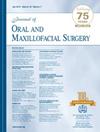单克隆抗体和小分子抑制剂与颌骨骨坏死相关:回顾性药物警戒研究。
IF 2.3
3区 医学
Q2 DENTISTRY, ORAL SURGERY & MEDICINE
引用次数: 0
摘要
背景:颌骨骨坏死(Osteonecrosis of the jaw, ONJ)是与单克隆抗体和小分子抑制剂等药物相关的不良反应。目的:研究单克隆抗体和小分子抑制剂与ONJ的关系。研究设计、环境、样本:研究设计为回顾性药物警戒病例系列。样本来自2004年3月至2024年3月美国食品和药物管理局不良事件报告系统数据库报告ONJ。纳入标准是与暴露于单克隆抗体(曲妥珠单抗、贝伐单抗、denosumab、elotuzumab、isatuximab、pertuzumab、ramucirumab、romosozumab和ado-曲妥珠单抗emtansine)和小分子抑制剂(abemacaciclib、alpelisib、axitinib、cabozantinib、lapatinib、lenvatinib、palbociclib、ribociclib和舒尼替尼)有关的ONJ发生的报告。排除标准是将单克隆抗体和小分子抑制剂对ONJ的作用与其他作用联系起来的报道。预测变量:不适用。主要结果变量:结果变量是情况状态,分为情况和非情况。病例定义为伴有单克隆抗体或小分子抑制剂的ONJ报告,而非病例定义为伴有其他不良事件的报告。次要结局变量是单克隆抗体/小分子抑制剂相关ONJ观察到的死亡、住院和残疾。协变量:年龄和性别为本研究纳入的协变量。分析:采用病例-非病例方法进行信号检测,采用频率分析(报告比值比[ROR]和比例报告比[PRR])和贝叶斯方法(信息成分95% CI下限[IC025])。ROR是通过比较某一特定药物报告ONJ的几率与所有其他药物报告相同事件的几率来确定的,PRR是通过特定药物报告ONJ的比例与所有其他药物报告ONJ的比例来估计的。信息成分定义为:根据数据库中总体报告率,观察到的含有主要可疑药物的ONJ相对于药物-ONJ对的预期频率的对数比。结果比较采用χ2检验(χ2), P≤0.05。结果:共纳入7402例报告,中位年龄61 ~ 76岁,以女性为主。Denosumab (ROR: 64.7 [62.5, 67];Prr: 61.9 [59.9, 64.1];P 2:12;df: 14;p = .6)。风险主要见于老年和女性患者。结论及相关性:Denosumab、romosozumab和lenvatinib与ONJ显著相关,特别是在老年和女性患者中。需要进一步研究以了解其机制并改进风险管理策略。本文章由计算机程序翻译,如有差异,请以英文原文为准。
Monoclonal Antibodies and Small-Molecule Inhibitors Associated Osteonecrosis of Jaw: A Retrospective Pharmacovigilance Study
Background
Osteonecrosis of the jaw (ONJ) is an adverse effect associated with medications such as monoclonal antibodies and small-molecule inhibitors.
Purpose
This study assesses the association between monoclonal antibodies and small-molecule inhibitors with ONJ.
Study Design, Setting, Sample
The study design was a retrospective pharmacovigilance case series. The sample was derived from the United States Food and Drug Administration Adverse Event Reporting System database reporting ONJ from March 2004 to March 2024. The inclusion criteria were the reports relating ONJ occurrence with exposure to monoclonal antibodies (trastuzumab, bevacizumab, denosumab, elotuzumab, isatuximab, pertuzumab, ramucirumab, romosozumab, and ado-trastuzumab emtansine) and small-molecule inhibitors (abemaciclib, alpelisib, axitinib, cabozantinib, lapatinib, lenvatinib, palbociclib, ribociclib, and sunitinib). The exclusion criteria were the reports associating the role of monoclonal antibodies and small molecule inhibitors to ONJ with roles other than primary suspicion.
Predictor Variable
Not applicable.
Main Outcome Variable
The outcome variable is the case status divided into case and noncase. Cases were defined as reports with ONJ associated with monoclonal antibodies or small-molecule inhibitors while noncases were the reports with other adverse events. Secondary outcome variables were death, hospitalization, and disability observed with monoclonal antibodies/small-molecule inhibitors–associated ONJ.
Covariates
Age and gender were the covariates included in this study.
Analyses
The case–noncase approach was applied for signal detection, using frequentist (reporting odds ratio [ROR] and proportional reporting ratio [PRR]) and Bayesian methods (lower limit of 95% CI of Information component [IC025]). The ROR is determined by comparing the odds of ONJ being reported for a given drug to the odds of the same event being reported for all other drugs and PRR is estimated by the ratio of proportion of reports for a specific drug with ONJ over the proportion of reports with ONJ for all other drugs. The information component is defined as defined as the logarithmic ratio of the observed ONJ with the primary suspected drug relative to the expected frequency of the drug-ONJ pair based on overall reporting rates in the database. Outcomes were analyzed with statistical comparisons using χ2 tests (χ2) at P ≤ .05.
Results
A total of 7,402 reports were included with median age ranging between 61 and 76 years with female preponderance. Denosumab (ROR: 64.7 [62.5, 67]; PRR: 61.9 [59.9, 64.1]; P < .05; and IC025: 5.1), romosozumab (ROR 4.2 [3, 6]; PRR: 4.2 [3, 6]; P < .05; and IC025: 1.5), and lenvatinib (ROR: 3.1 [2.3, 4.2]; PRR: 3.1 [2.3, 4.1]; P < .05; and IC025: 1.2) showed positive signals for ONJ compared to all other drugs in the database by both frequentist and Bayesian analyses indicating a potential association. Sixty-two point eight percent cases resulted in hospitalization and was no significant differences were observed in the distribution of outcomes between the monoclonal antibodies and small molecule inhibitors (χ2: 12; df: 14; P = .6). The risk was mainly observed in elderly and female patients.
Conclusion and Relevance
Denosumab, romosozumab, and lenvatinib are significantly associated with ONJ, particularly in older and female patients. Further research is needed to understand the mechanisms and improve risk management strategies.
求助全文
通过发布文献求助,成功后即可免费获取论文全文。
去求助
来源期刊

Journal of Oral and Maxillofacial Surgery
医学-牙科与口腔外科
CiteScore
4.00
自引率
5.30%
发文量
0
审稿时长
41 days
期刊介绍:
This monthly journal offers comprehensive coverage of new techniques, important developments and innovative ideas in oral and maxillofacial surgery. Practice-applicable articles help develop the methods used to handle dentoalveolar surgery, facial injuries and deformities, TMJ disorders, oral cancer, jaw reconstruction, anesthesia and analgesia. The journal also includes specifics on new instruments and diagnostic equipment and modern therapeutic drugs and devices. Journal of Oral and Maxillofacial Surgery is recommended for first or priority subscription by the Dental Section of the Medical Library Association.
 求助内容:
求助内容: 应助结果提醒方式:
应助结果提醒方式:


